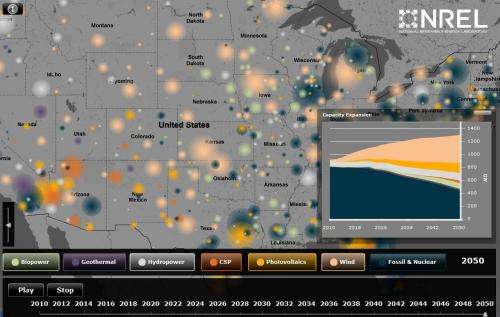June 20, 2012 report
Renewables can fill 80 percent electricity demand in U.S. in 2050

(Phys.org) -- In the United States, renewable energy sources could supply 80 percent of electricity demand in 2050 just by using technologies commercially available today. That is the word from a new report from the National Renewable Energy Laboratory, Renewable Electricity Futures Study (RE Futures). The report offers a detailed focus on the extent to which U.S. electricity needs can be supplied by renewable energy sources, including biomass, geothermal, hydropower, solar, and wind.
The lineup of renewable electricity technologies is discussed from a national perspective. The study’s overall position is that a future U.S. electricity system largely powered by renewable sources is possible and that further work is warranted to investigate “this clean generation pathway.“
Reaching an 80 percent-renewables goal by 2050, says the study, will involve fifty percent of electricity coming from wind and photovoltaics. “The analysis treats a variety of scenarios with prescribed levels of renewable electricity generation in 2050, from 30% to 90%, with a focus on 80% (with nearly 50% from variable wind and solar photovoltaic generation).”
A diverse mix of renewable energy resources, such as geothermal, solar, wind and wave energy, can support multiple combinations of renewable technologies. The results would be meaningful reductions in electric sector greenhouse gas emissions and water use. The study finds no geographical gaps in achieving the 2050 goal. "All regions of the United States could contribute substantial renewable electricity supply in 2050, consistent with their local renewable resource base."
Hydropower is the biggest renewable contributor, but hydropower plays less of a role over the next few decades. NREL suggests a growing role for offshore wind. NREL also says dedicated biomass power plants, as opposed to just feeding biomass to coal plants, are needed.
The study is significant as the most comprehensive analysis of high-penetration renewable electricity of the United States to date. IEEE Spectrum comments that the study may also impact debates over renewable and their future. “The fossil fuel supporters who claim coal and natural gas will always be required to provide baseload power are standing on shakier ground all the time.”
The study maintains that reaching the 80 percent goal is not insurmountable, but only if the right changes are made.
"While this analysis suggests such a high renewable generation future is possible, a transformation of the electricity system would need to occur to make this future a reality. This transformation, involving every element of the grid, from system planning through operation, would need to ensure adequate planning and operating reserves, increased flexibility of the electric system, and expanded multi-state transmission infrastructure, and would likely rely on the development and adoption of technology advances, new operating procedures, evolved business models, and new market rules."
More information: www.nrel.gov/analysis/re_futures/
© 2012 Phys.Org




















